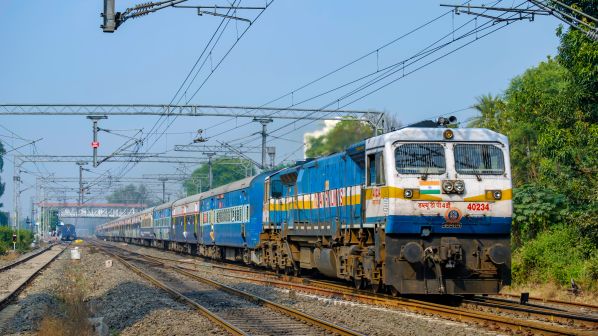INDIAN finance minister, Ms Nirmala Sitharaman, unveiled a Rs 2.15 trillion ($US 29.3bn) capital budget for Indian Railways (IR) during the 2021-22 budget announcement on February 1. The outlay, which is Rs 540bn larger than in 2020-21, is the highest-ever budget for the railway.
The increase is in line with the Indian government’s strategy to increase public spending to counteract the adverse effects of the Covid-19 pandemic on the country's economy.
Of the total capital expenditure, Rs 75bn will come from internal resources, Rupees 1.002 trillion from extra budgetary resources, and Rs 1.071 trillion from a capital expenditure allocation through the general budget.
Outlining plans to provide for a “Future-Ready” network, and in line with the recent National Rail Plan 2030, Sitharaman said the larger allocation would enable IR to complete vital infrastructure projects, increase capacity and install safety enhancement measures, including the locally developed Train Collision Avoidance System (T-CAS) on IR’s high-density networks.
Rs 409bn will be spent on new lines, a 52% increase on last year, with Rs 261bn for track-doubling (+17%) and Rs 322bn (+138%) allocated for investment through Public Sector Undertakings, Joint Ventures and Special Purpose Vehicles.
As well as announcing that the Eastern and Western Dedicated Freight Corridors (DFC) will be completed by June 2022, Sitharaman said the 263km Sonnagar - Gomoh section and the 274km Gomoh - Dankuni section of the Eastern corridor will be developed through public-private Partnerships (PPP) in 2021-22. The two DFCs have been allocated Rs 160bn.
Over the coming year, detailed project reports will be developed for future DFCs, including the East Coast Corridor from Kharakpur to Vijaywada, East-West Corridor from Bhusaval to Kharakpur to Dankuni and the North-South Corridor from Itarsi to Vijaywada.
The Mumbai - Ahmedabad high-speed project has been allocated Rs 372bn. Another seven new high-speed lines are proposed: the 865km Delhi - Agra - Varanasi line; the 760km Varanasi - Patna - Howrah line; the 886km Delhi - Jaipur - Ahmedabad line; the 459km Delhi - Chandigarh - Amritsar line; the 753km Mumbai - Nashik - Nagpur corridor; the 711km Mumbai - Pune - Hyderabad corridor; and the 435km Chennai - Bengaluru - Mysore corridor.
A detailed project report for the Delhi - Agra - Varanasi line has been completed and submitted to the Railway Board, while similar reports for the other lines are expected to be submitted over the coming financial year.
Sitharaman has also allocated Rs129bn for rail projects in Jammu, Kashmir and other hilly states, including Uttarakhand, Himachal and the Northeastern states.
The Indian government has also decided to launch a “National Monetisation Pipeline” of potential brownfield infrastructure assets such as the DFCs, with plans to create an “asset monetisation dashboard” to track progress and provide visibility to investors.
The government is planning to electrify 100% of the broad-gauge network, and improve passenger comfort through measures such as the introduction of vista dome LHB coaches.
Metros
Funding for metro systems has also been increased, with the government allocating Rs 19.6bn for the 11.5km Phase 11 of the Kochi metro; Rs 632bn for the 118km Phase 11 of Chennai Metro; Rs 147bn for Phase 2A and 2B of the Bengaluru Metro Rail; Rs 59bn for Nagpur Metro Rail Phase 11; and Rs 20bn for the Nashik Metro.
Alternative transport systems such as the “Metro Lite” and “MetroNeo” will also be deployed as low-cost transport options.
There is currently 702km of metro operating across India, with another 1016km of metro and Rapid Rail Transport System (RRTS) lines under construction across 27 cities.
For detailed data in projects and fleet orders in India, subscribe to IRJ Pro.

